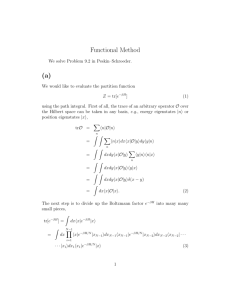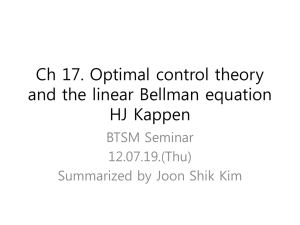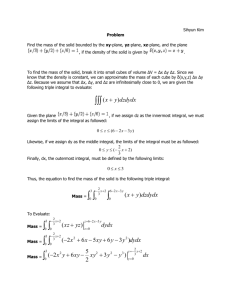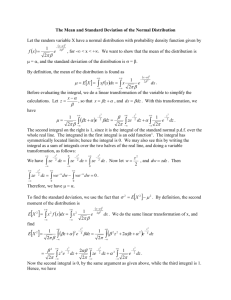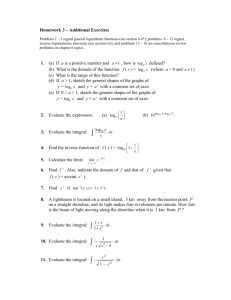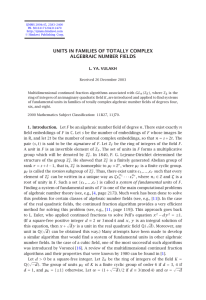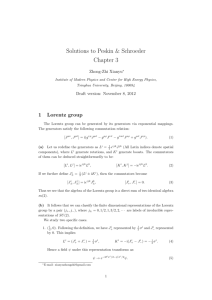Solutions to Peskin & Schroeder Chapter 9
advertisement
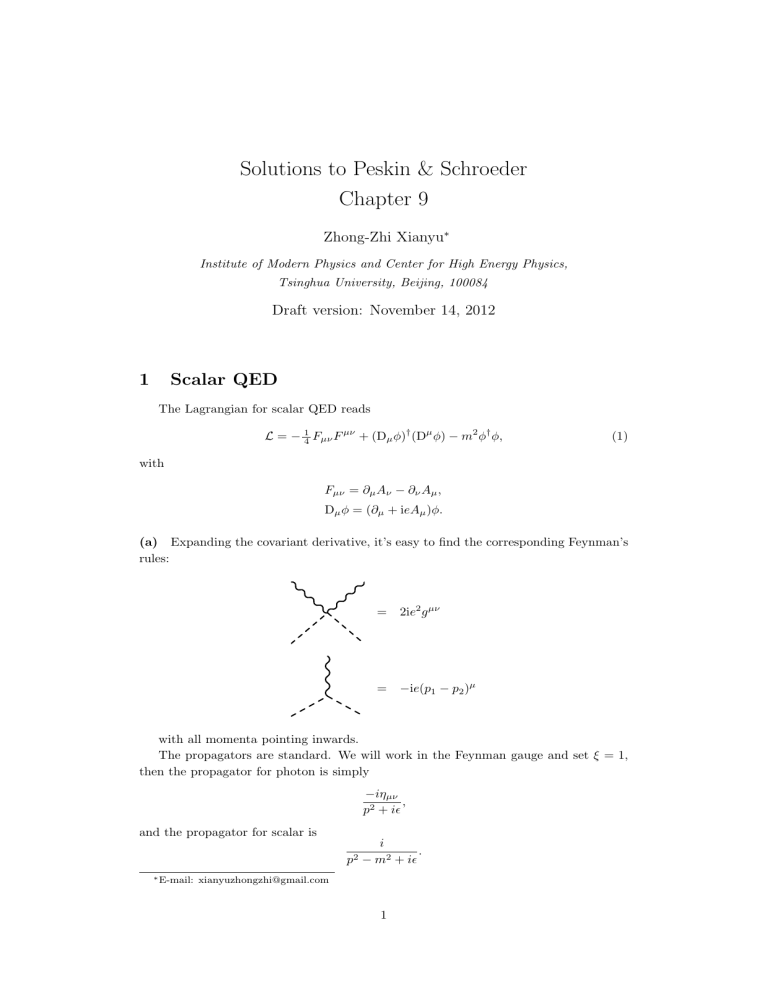
Solutions to Peskin & Schroeder Chapter 9 Zhong-Zhi Xianyu∗ Institute of Modern Physics and Center for High Energy Physics, Tsinghua University, Beijing, 100084 Draft version: November 14, 2012 1 Scalar QED The Lagrangian for scalar QED reads L = − 41 Fµν F µν + (Dµ ϕ)† (Dµ ϕ) − m2 ϕ† ϕ, (1) with Fµν = ∂µ Aν − ∂ν Aµ , Dµ ϕ = (∂µ + ieAµ )ϕ. (a) Expanding the covariant derivative, it’s easy to find the corresponding Feynman’s rules: = 2ie2 g µν = −ie(p1 − p2 )µ with all momenta pointing inwards. The propagators are standard. We will work in the Feynman gauge and set ξ = 1, then the propagator for photon is simply −iηµν , p2 + iϵ and the propagator for scalar is i . p2 − m2 + iϵ ∗ E-mail: xianyuzhongzhi@gmail.com 1 Notes by Zhong-Zhi Xianyu Solution to P&S, Chapter 9 (draft version) (b) Now we calculate the spin-averaged differential cross section for the process e+ e− → ϕ∗ ϕ. The scattering amplitude is given by iM = (−ie)2 v̄(k2 )γ µ u(k1 ) −i (p1 − p2 )µ . s (2) Then the spin-averaged and squared amplitude is [ ] 1 ∑ e4 |M|2 = 2 tr (p k 1 (p k2 /1 − p /2 )/ /1 − p /2 )/ 4 4s spins ] e [ 8(k1 · p1 − k1 · p2 )(k2 · p1 − k2 · p2 ) − 4(k1 · k2 )(p1 − p2 )2 . 4s2 4 = (3) We may parameterize the momenta as with p = √ k1 = (E, 0, 0, E), p1 = (E, p sin θ, 0, p cos θ), k2 = (E, 0, 0, −E), p2 = (E, −p sin θ, 0, −p cos θ), E 2 − m2 . Then we have e4 p2 1 ∑ |M|2 = sin2 θ. 4 2E 2 (4) spins Thus the differential cross section is: ( dσ ) ( ∑ ) 1 p α2 ( m2 )3/2 2 1 = |M|2 = 1− 2 sin θ. 4 2 2 dΩ CM 2(2E) 8(2π) E 8s E (5) (c) ∫ ∫ dd k i dd k (p − 2k)µ (p − 2k)ν 2 − (−ie) d 2 2 (2π) k − m (2π)d (k 2 − m2 )((p − k)2 − m2 ) ( ) ∫ dd k 2ηµν (p − k)2 − m2 − (p − 2k)µ (p − 2k)ν 2 ( ) =−e (2π)d (k 2 − m2 ) (p − k)2 − m2 ( ) ∫ ∫ 1 2ηµν k ′2 + (1 − x)2 p2 − m2 + (1 − 2x)2 pµ pν + 4k ′µ k ′ν dd k ′ = − e2 dx (2π)d 0 (k ′2 − ∆)2 ( ) ∫ ∫ 1 2ηµν k ′2 (1 − d2 ) + 2ηµν (1 − x)2 p2 − m2 − (1 − 2x)2 pµ pν dd k ′ 2 .=−e dx (2π)d 0 (k ′2 − ∆)2 d d [ 2 ∫ 1 (1 − 2 )Γ(1 − 2 )2ηµν −ie = dx d/2 (4π) ∆2−d/2 0 ( ) )] Γ(2 − d2 ) ( 2 2 2 2 + 2η (1 − x) p − m − (1 − 2x) p p µν µ ν ∆2−d/2 2 ∫ 1 ) ] Γ(2 − d2 ) [ ( −ie dx 2 (1 − x)2 − x(1 − x) p2 ηµν − (1 − 2x)2 pµ pν . (6) = d/2 2−d/2 (4π) ∆ 0 ( ) We can symmetrize the integrand as (1 − x)2 → 12 (1 − x)2 + x2 , then we get δΠµν = 2ie2 ηµν δΠµν = −ie2 (4π)d/2 ∫ 1 dx 0 ) Γ(2 − d2 ) (1 − 2x)2 (p2 ηµν − pµ pν . 2−d/2 ∆ 2 (7) Notes by Zhong-Zhi Xianyu 2 Solution to P&S, Chapter 9 (draft version) Quantum statistical mechanics In this problem we study the path integral formulation in statistical mechanics. The theory can be described by the partition function: Z = tr e−βH , (8) where H is the Hamiltonian of the system. It is a function of the generalized coordinates q and the corresponding conjugate momentum p. In this problem, we simply assume the Hamiltonian has the following form: H= p2 + V (q). 2m (9) We assume the dimension of the configuration space is d, then both q and p have d components. Then we assume the eigenstates of both q and p form a complete orthonormal basis of the Hilbert space: ∫ ∫ dd p 1 = dd q |q⟩⟨q|; 1= |p⟩⟨p|. (10) (2π)d Then the partition function can be written as ∫ −βH Z = tr e = dd q ⟨q|e−βH |q⟩. (11) (a) Now we derive a path integral expression for the partition function. Following the same way of deriving path integral in a quantum field theory, we separate the quantity e−βH into N factors: e−βH = e−ϵH · · · e−ϵH , (N factors), then inserting a complete basis between each pair of adjacent factors, as ∫ −βH e = dd q1 · · · dd qN −1 ⟨q|e−ϵH |qN −1 ⟩⟨qN −1 |e−ϵH |qN −2 ⟩ · · · ⟨q1 |e−ϵH |q⟩. Now we focus on one factors: ⟨qi+1 |e−ϵH |qi ⟩ = ⟨qi+1 |e−ϵ and ) 1 2 2m p +V (q) ϵ |qi ⟩ = e−ϵV (qi ) ⟨qi+1 |e− 2m p |qi ⟩, 2 ∫ 2 dd pi+1 dd pi ⟨qi+1 |pi+1 ⟩⟨pi+1 |e−ϵp /2m |pi ⟩⟨pi |qi ⟩ (2π)d (2π)d ∫ dd p ip(qi+1 −qi ) −ϵp2 /2m [ m ]d/2 −m(qi+1 −qi )2 /2ϵ = e e = 2πϵ e . (2π)d ϵ − 2m p2 ⟨qi+1 |e ( |qi ⟩ = Inserting all this into the partition function, we get: N ∫ [ m ]N d/2 ∏ ] [ m(qi+1 − qi )2 Z= − ϵV (qi ) , dd qi exp − 2πϵ 2ϵ i=0 with qN +1 = q0 . Now let N → ∞, then we have ∫ I [ ] Z = Dq exp − β dτ LE (τ ) , 3 (12) (13) Notes by Zhong-Zhi Xianyu Solution to P&S, Chapter 9 (draft version) where the integral measure is defined by Dq = lim N →∞ [ m ]N d/2 ∏ d d qi , 2πϵ(N ) i=0 N (14) and LE (τ ) is a Lagrangian in Euclidean form: LE (τ ) = m ( dq )2 + V (q(τ )). 2 dτ (15) Note that the periodic integral on τ comes from the trace in the partition function. (b) Now we study an explicit example, a simple harmonic oscillator, which can by defined by the Lagrangian LE = 12 q̇ 2 + 21 ω 2 q 2 . (16) Our task is to complete the path integral to find a expression for the partition function of harmonic oscillator. This can be easily done by a Fourier transformation of the coordinates q(τ ) with respect to τ . Since the “time” direction is periodic, the Fourier spectrum of q is discrete. That is, ∑ q(τ ) = β −1/2 e2πinτ /β qn , (17) n Then we have: ∫ ∫ ] 1 ∑ [( 2πi )2 dτ LE (τ ) = dτ mn + ω 2 qm qn e2πi(m+n)τ /β 2β m,n β ] ] 1 ∑ [( 2πi )2 1 ∑ [( 2π )2 2 = mn + ω 2 qm qn δm,−n = n + ω 2 qn q−n 2 m,n β 2 β n∈Z ] 1 ∑ [( 2π )2 2 n + ω 2 |qn |2 (18) = 2 β n∈Z Then the path integral can be written as ∫ ∫ ∏ [ ) ] β ( 4π 2 n2 −βω 2 q02 2 2 Z = C dq0 e dReqn dImqn exp − + ω |q | n 2 β2 n>0 ]−1 C ∏ [ 4π 2 n2 C ∏[ 1 ( βω )2 ]−1 2 = + ω = 1 + ω n>0 β2 ω n>0 (πn)2 2 ∑ ] [ = C sinh−1 (βω/2) = C exp − βω(n + 12 ) . (19) n≥0 (c) From now on we will consider the statistics of fields. We study the statistical properties of boson system, fermion system, and photon system. For a scalar field, the Lagrangian is given by ∫ ] ( )2 1[ 2 (20) ϕ̇ (τ, x) + ∇ϕ(τ, x) + m2 ϕ2 (τ, x) . LE (τ ) = d3 x 2 Following the method we used to deal with the simple harmonic oscillator, here we decompose the scalar field ϕ(τ, x) into eigenmodes in momentum space: ∫ ∑ d3 k ik·x 2πinτ /β −1/2 e ϕ(τ, x) = β e ϕn,k . (21) (2π)3 n 4 Notes by Zhong-Zhi Xianyu Solution to P&S, Chapter 9 (draft version) Then the Lagrangian can also be rewritten in terms of modes, as ] ∫ ∫ ∑ ∫ d3 kd3 k ′ 1 [( 2πi )2 ′ ′ 2 dτ LE (τ ) = dτ d3 x n n − k · k + m (2π)6 2β β ′ n,n ′ ′ × ϕn,k ϕn′ ,k′ ei2π(n +n)τ /β+i(k+k )·x [ ] ∫ d3 k ( 2π )2 2 1 ∑ 2 2 n + k + m |ϕn,k |2 = 2 n (2π)3 β [ ) ] ∫ ∑ (( 2π )2 d3 k 1 2 2 2 2 2 ω |ϕ0,k | + = n + ωk |ϕn,k | , (2π)3 2 k β n>0 (22) where ωk2 = k2 + m2 . Then the partition function, as a path integral over the field configurations can be represented by [ (( ) ] ∫ ∏ 2π )2 2 Z=C Reϕn,k Imϕn,k exp − β n + ωk2 |ϕn,k |2 (23) β n>0,k By the calculation similar to that in (b), we get )]−1 [ ∏ [ ∏ ( 4π 2 n2 ∏ ( 2 Z=C ωk + ω = C exp − βωk n + k 2 β n>0 k )] . (24) k This product gives the meaning to the formal expression proper regularization. (d) 1 2 [ det(−∂ 2 + m2 ) Then consider the fermionic oscillator. The action is given by ∫ ∫ ( ) S = dτ LE (τ ) = dτ ψ̄(τ )ψ̇(τ ) + ω ψ̄(τ )ψ(τ ) . ]−1/2 with (25) The antiperiodic boundary condition ψ(τ + β) = −ψ(τ ) is crucial to expanding the fermion into modes: ∑ e2πiτ /β ψn . (26) ψ(τ ) = β −1/2 n∈Z+1/2 Then the partition function can be evaluated to be [ ( ) ] ∫ ∏ ∑ 2πin Z= dψ̄n dψn − β ψ̄n + ω ψn β n n∈Z+1/2 ∞ ( ) ∏ 4π 2 (n + + ω = C(β) β β2 n=0 n∈Z+1/2 ) ( ( ) = C(β) cosh 12 βω = C(β) eβω/2 + e−βω/2 , = C(β) ∏ ( 2πin 1 2 2) + ω2 ) (27) with the form of a two-level system, as expected. (e) Finally we consider the system of photons. The partition function is given by [∫ ] ∫ ( 1 ) 3 2 µ 2 Z = DAµ DbDc exp dτ d x − 2 Aµ ∂ A − b∂ c [ ]4·(−1/2) = C(β) det(−∂) · det(−∂ 2 ), 5 (28) Notes by Zhong-Zhi Xianyu Solution to P&S, Chapter 9 (draft version) where the first determinant comes from the integral over the vector field Aµ while the second one comes from the integral over the ghost fields. Therefore [ ]2·(−1/2) Z = C(β) det(−∂ 2 ) , (29) which shows the contributions from the two physical polarizations of a photon. Here we see the effect of the ghost fields of eliminating the additional two unphysical polarizations of a vector field. 6
